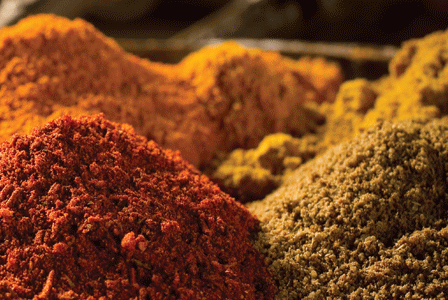
Spices have been valued for millennia for their ability to cure all that ails. Today researchers continue to confirm the health benefits of many spices.
Explorers have gone in search of them, wars have been sparked over them, and at times they have been worth more than gold. Spices have been valued for millennia for their flavour and their ability to cure all that ails.
Today researchers continue to uncover evidence to confirm the disease-fighting and health-promoting abilities of many spices. Packed full of nutrients and antioxidants, the following 10 spices are just as good for you as they taste.
Cinnamon
A traditional holiday spice, cinnamon is not only a yummy addition to hot apple cider, but may also be an effective defense against metabolic syndrome, cardiovascular disease, and diabetes.
Studies have shown that as little as 1 g of cinnamon consumed daily may be able to improve blood sugar, cholesterol, and triglyceride levels in people with type 2 diabetes. Scientists believe the flavonoid procyanidin, which may increase insulin sensitivity, is behind these positive effects.
Garlic
Fabled for its ability to ward off vampires, garlic has been used since ancient Egyptian times to protect against disease and illness.
Garlic’s disease-fighting qualities appear to come from the sulfur compounds that are responsible for its pungent smell. Studies have found that these sulphur compounds, allicin in particular, may prevent a wide range of illnesses including heart disease, cancer, and even the common cold.
Ginger
Used for over 2,000 years in Chinese medicine to treat nausea, scientists are discovering that ginger may have pain-relieving qualities as well.
Researchers from Georgia College & State University found that when participants consumed 2 g of either raw or heat-treated ginger for eight days prior to performing strenuous exercise, post-workout pain was reduced by 25 percent.
Although results are mixed, the anti-inflammatory properties of ginger may also be beneficial in treating arthritis. One study found ginger to be nearly as effective as the drug Ibuprofen in treating osteoarthritis pain.
Turmeric
Traditionally used to reduce inflammation and disinfect wounds, this yellow spice that gives Indian food its distinctive flavour is proving to be a health superstar.
Turmeric’s multitude of health benefits appear to come from curcumin, the powerful polyphenol it contains. Researchers have found curcumin molecules may be able to increase cell resistance to infection and disease by inserting themselves into cell membranes, making the cells more stable.
Preliminary studies suggest curcumin may be useful in reducing inflammation, increasing cognitive function, and preventing cancer and diabetes.
Oregano
Colon cancer rates among cultures that traditionally eat a Mediterranean diet tend to be low. Scientists believe the use of oregano may have something to do with this. Preliminary evidence suggests oregano may be able to induce death in cancer cells.
Oregano’s health benefits don’t stop there. Research is showing that the chemical beta-caryophyllene found in oregano may inhibit inflammation. Researchers believe this anti-inflammatory effect may be useful in treating osteoporosis, arteriosclerosis, and Crohn’s disease.
Rosemary
Another popular Mediterranean spice, rosemary is a good source of free radical-fighting vitamin A, immune-boosting vitamin C, and bone-building calcium.
In addition to its nutritional value, rosemary contains carnosol, a powerful antioxidant that has shown promise in inhibiting the development of breast cancer and leukemia.
Studies have also found carnosol to be an effective defence against oral bacteria, including the cavity-causing Streptococcus mutans.
Cloves
A good source of vitamins C and E, dietary fibre, calcium, and iron, cloves are not only nutrient dense but also antioxidant rich.
When compared to four other popular Mediterranean spices, Spanish researchers found that cloves came out on top in terms of antioxidant activity.
One antioxidant found in cloves, eugenol, has been shown in numerous studies to control pain and inflammation and to have antibacterial effects. Because of this, clove oil is often used topically to relieve tooth pain.
Cayenne pepper
Recognized for over 9,000 years by Native Americans for its medicinal properties, cayenne pepper contains a high concentration of the health-promoting compound capsaicin.
Often used to treat muscle and arthritis pain, capsaicin appears to inhibit the body from sending pain messages to the brain when applied topically.
Researchers have also found this heat-producing chemical may be a useful weight loss aid. When consumed, studies have shown capsaicin to decrease appetite and increase fat oxidation, especially in the abdominal region.
Saffron
Traditionally used in Persian medicine to elevate mood, research out of Iran suggests this popular Asian spice may be just as effective as the drug fluoxetine in treating mild to moderate depression.
In one study, participants took either a 30 mg dose of saffron or a 20 mg dose of fluoxetine daily for eight weeks. At the end of the study period, both groups showed significant improvements in depressive symptoms, with no noticeable difference between the
two groups.
Like fluoxetine, extracts from saffron are thought to increase levels of the feel good chemical serotonin in the brain.
Sage
In 1597 herbalist John Gerard wrote that sage “is singular good for the head and braine; it quickeneth the sences and memory.” British research suggests Gerard was right.
Scientists from Northumbria University found that when healthy young adults were given either a 25 or 50 mcl dose of sage essential oil, the participants performed better on memory tests and also reported an increased sense of calm and happiness.
Evidence is also emerging to suggest that the brain-boosting power of sage may provide protection against Alzheimer’s disease as well.
|
Best kept fresh When properly stored, ground spices can last for up to three years and whole spices as long as four. The following tips will help you get the most flavour and health benefits out of your spice rack.
|

